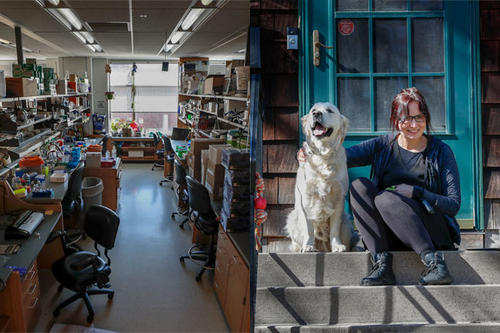
They aim to build synthetic life. “Life but not alive” Kate Adamala calls it.
In her lab on the Twin Cities campus, U of M biochemist Kate Adamala’s research group has been building synthetic cells from scratch. “We build cells,” she says, “to understand life—how life began and evolved on Earth, what limits life, what is the future of life. We push forward the definition of life and, in doing so, develop tools for the biotechnology and medicine of tomorrow.”
In mid March, when Adamala’s lab was forced to shut down for COVID-19 precautions, her group’s grand vision was put on pause—but not on pause.
“We’ve continued our work from home,” she says.
Shutting down
Thanks to early communications from University of Minnesota leaders, Adamala’s group had several days to prepare for the shutdown—freezing and storing substances and specimens, moving bottles away from work benches, inventorying stocks, and throwing away anything with less than a month of shelf life.
Lab members took home needed computer equipment to set up their temporary offices. Adamala had everyone write summaries of where projects were at and what next steps were planned. As with other U of M labs, a few members of her group were designated as emergency personnel, going to campus a couple of times a week to check on their lab.
Pushing forward
At any given time about 10 people are involved in Adamala’s research group, including undergrads. It’s impossible to re-create via Zoom all of the personal interactions, spontaneous discussions, and exchanging of ideas that happens in a lab. “I miss the variety of the day,” she says. “I also miss going into the lab….I don’t get to hold a pipette.”
Yet their work remains focused, knowing that research will be crucial to economic recovery and to preventing the next worldwide pandemic. “Building better tools for biotechnology and medicine—that’s a great motivator,” Adamala says.
Experiments are a challenge
“We can’t gather experimental data, so planning future experiments is very difficult,” she says. “Analyzing data is challenging too because we can’t do any quick follow-up experiments that would verify a hypothesis.”
Adamala’s group is fortunate to have several projects with lots of data already gathered. “We’re analyzing data, writing papers, and writing grants,” she says. “We have a few computational biology projects going as well.”
Teaching is harder
“Personal contact with students is invaluable, and it’s hard to replace that with emails and calls. I’m impressed with how students in my class are dealing with the transition to remote learning.”
An international research community
Much of Adamala’s research collaborations are international. So her daily scientific interactions have always been mostly Zoom based.
“We have a great international community of synthetic cell engineers,” she says. “Since the global shutdown, we’ve been meeting once a week for a virtual seminar series. This helps us maintain a sense of community and keep the ideas flowing.”
Home ‘labs’
Some experiments can be carried out at home. One of Adamala’s postdocs has a 3D printer at home and is fabricating parts for microfluidics rigs. Another student is assembling a photobioreactor.
And then there are the cooking experiments in lab members’ kitchens. “The results of those are worthy of prestigious publications,” she says.
New members of the team
Finally, Adamala reports that her team has drawn fresh support in their work from home—
Dogs Dug, Krishna, Lola, Lucky, and Meera; cat Lucy; chinchilla Chinchilla; guinea pigs Piglet and Pooh; and hamster Thor have all added love and humor to each work day.
- Categories:
- Science and Technology
- COVID-19





